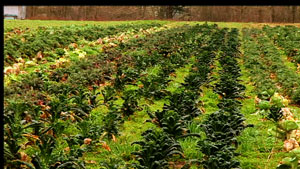One of my favorite vegetables goes by many names, and by any name, it tastes sweet. At least in the coldest months of winter. That’s when the deep blue-green, ostrich feather-shaped leaves of this, and all varieties of kale are at their most abundant and flavorful.
In an effort to learn where our food comes from, and to inspire more fresh, seasonal cooking, this two-part video series, with Cookbook author Ivy Manning, goes into the field, and back into the kitchen, for a round-trip exploration of Pacific Northwest kale. In this segment, Manning visits Shari Sirkin of Dancing Roots Farm in Troutdale, Oregon to investigate Kale from a farmer’s perspective in the midst of harvesting it.
Just as everything else in the garden is languishing in the cold, the brassica oleracea family (which includes flowering kale, white, red, and curly kale varieties) thrives in the nippy weather, supplying our kitchens with a fresh, tender green when we’ve had our fill of root vegetables. I first learned of lacinato kale working in Italy, where the leaves where stripped from their tough stems, chopped and shoved by huge handfuls into pots of minestrone. “Cavolo nero, it likes to be cooked with beans. It’s a bean-green,” I was told by the chef I was assisting.
I took the chef’s word and used lacinato kale exclusively in soups, simmering it until it became a silky slip of a green. Until one day, I had a hankering for Southern greens over cornbread. I didn’t have collard greens on hand, but I did have a fresh bunch of lacinato kale, so I cooked as I would collard or mustard greens—sautéed in bacon fat with onions, garlic, and a pinch of chili flakes. Lacinato cooked in a quarter of the time collards usually take, and the deep, rich flavor and almost meaty texture had me smitten. The “bean green” easily slipped its way into my culinary repertoire as a favorite winter vegetable with endless applications. It’s great in soups, yes, but try it sautéed in olive oil or bacon fat and garlic with a pinch of red pepper flakes, blanch it and add it to stuffing, wok-fry it and dress it with sesame oil and soy sauce, marinated it raw in vinaigrette for a winter salad– the possibilities are endless. Before you head into the kitchen to become acquainted with these tall dark and handsome leaves, you’ll want to keep a few things in mind:
- Choose small to medium leaves, and avoid bunches of lacinato kale that have yellowed or wilting leaves.
- Wash the leaves in a sink full of cool water. If you find any powdery bugs on the underside of the leaves, dissolve a few tablespoons of salt in the water and soak for ten minutes; the bugs will jump ship.
- Store all kale varieties in a plastic bag in the coldest part of the refrigerator and use it within a few days—kale will begin to break down and loose its fresh flavor quickly.
- Tear the dark leaves away from the tough center rib/stem; the rib/stems do not break down while cooking. Use the rib/stems for stocks or compost.
Stayed tuned for the companion Cooking Fresh video— To the Kitchen: Twice Baked Potatoes with Kale!
Next week— Ivy Manning goes into the kitchen to demonstrate how to prepare an incredibly tasty meal, using this fresh kale, and a few other simple ingredients. Manning also shares the following written thoughts about Kale: Tuscan black, cavalo nero, lacinato, dinosaur.
Ivy Manning is the author of The Farm to Table Cookbook and The Adaptable Feast. She also writes the “Vegetarian Flavors” column in the Oregonian FoodDay and is a frequent contributor to Cooking Light and Bon Appetite magazine. Visit her website and blog.
Most of the videos featured on Cooking Up a Story were produced, filmed, and edited by Rebecca Gerendasy. Fred Gerendasy contributed as a writer to many of the posts and occasionally as the interviewer. Visit Rebecca Gerendasy Clay – Art and Fred Gerendasy Photography to see their current work.

